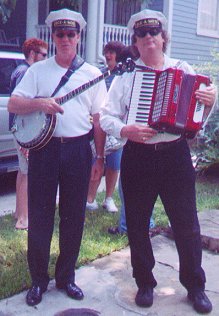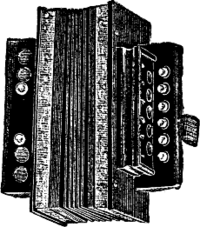Accordion
|
|
Template:Squeezebox An accordion is a small portable free-reed wind instrument with a keyboard, the smallest representative of the organ family.
It is possible that some ancient civilisation had reed instruments. It has been suggested that they may have existed in ancient Egypt.
Simple metal or wood reed instruments ("Maultrommel", Jews' Harp) were likely precursors.
Characteristics
Sound is made by a thin metal ribbon, a reed, which is held at one end and free at the other, like a ruler on the edge of a table top. The reed is fitted inside a holder plate, and as air is drawn through the hole in the holder, the reed vibrates, producing sound.
Modern free-reed instruments have several aspects in common:
- Reeds sound only if air flows in one direction
- Metal frame and metal tongue
- Activation of sound through air (Bernoulli effect)
- Reed tone pitch is given by the reed itself and not through a resonator tube (as opposed to woodwind instruments)
Some of these characteristics are true for the sheng and some are true for the Jew's Harp, but not all are true for all of them.
Reeds with these characteristics were first used in Europe around 1800 AD for organs. People used their knowledge and the standard of the contemporary technology to produce reeds, so as technology has changed, so have the reeds.
The Chinese sheng (笙) is a mouth-blown instrument. It is thought that a traveler to China in the 1800s brought this idea back to Europe. However, the sheng uses resonator pipes, and the reeds can sound in both directions, which is more similar to a clarinet than a modern free-reed instrument.
The first instrument using steel reeds with steel frames was a Querhammerfl?ith Aoline, made by Kasper Schimmelbach and K?shafen Bayern, circa 1815 (MIM Kat.-Nr.: 5321). Each reed had different dimensions to produce the different tones. The frame and tongue were made in one part, as is the case with Jew's Harps. The reeds were mounted on a wooden soundboard, similar to concertinas. The first basic "accordion" was invented in 1822 by Friedrich Buschmann in Berlin. Buschmann used it as a tool to have a reference for tuning other instruments. It had free reeds, but no keyboard, and sounded only in one direction. The first modern accordion was a 10-button accordion, invented in 1829 by Cyrillus Damian in Vienna. It had the seven notes of a major scale, and consequently played in only one key [and its related keys]. Similar accordions are still played today, under various names: Cajun accordions, melodeons, one-row, diatonic accordions, and so on. Damian's instruments were much smaller than modern variants. His first patent had chords sounding for each note. The instrument was copied by many people, and many variations came into existence in a very short time. Most of the variants were single-action instruments, where each button produces two different notes: one when pulling the bellows outwards, another when pushing them inwards. The notes are arranged much like on a harmonica. From 1829 on, many different patents were granted in Vienna and across Europe for accordion innovations, but it is impossible to say that the accordion was patented. Patent always belonged to some parts or different styles. New patents continue to be granted for accordion-related innovations.
A special key layout was patented on January 14, 1854 by Anthony Faas. It is not in use today.
The accordion consists of folded bellows, to which a keyboard is attached. The keyboard may have anywhere from 5 to 50 keys. While the bellows are being worked, depressed keys open valves, admitting wind to pass over free-reeds, which consist of narrow tongues of metal. Some reeds are riveted to the upper board of the bellows, some to the lower board. Similarly, their free ends are bent, some inwards, some outwards. Each key produces two notes: one from the inwardly bent reed when the bellows are compressed, the other from the outwardly bent reed by suction when the bellows are expanded. The pitch of the note is determined by the length and thickness of the reeds, reduction of the length tending to sharpen the note, while reduction of the thickness lowers it. The right hand plays the melody on the keyboard, while the left works the bellows and manipulates the two or three bass harmony keys, which sound the simple chords of the tonic and dominant.
Related instruments include the concertina and the melodeon.
The piano accordion was developed in Europe in the late 1800s and has become the most common type of accordion. Familiar to everyone who has ever seen Lawrence Welk, the right hand is laid out like a piano keyboard, so a piano player could play it, though the keys are smaller than on a piano. The left hand plays an arrangement of up to 120 buttons which play bass notes and various chords. The instrument was named and popularized in the United States by Count Guido Deiro who was the first piano accordionist to perform in Vaudeville. He is credited with making the first recordings of the instrument in 1908, making the first radio broadcast of the accordion in 1921 and the first sound motion picture featuring the accordion, for Vitaphone, in 1928.
The left hand layout of a piano accordion (and also some other types) uses "The Stradella Bass System". This usually features six rows: the second row buttons are called the Fundamental Bass and are ordered in quints, the first row buttons are called the Counter Bass and are a major third up relative to the second row. The major chords are in the third row, the fourth row consists of the minor chords, the fifth row houses the seventh chord and finally the sixth row has the diminished seventh chords.
The layout can be roughly described by this ASCII Art:
... C G D A E B F# C# G# D# A# F C ...
... Ab Eb Bb F C G D A E B F# C# G# ...
... ab eb bb f c g d a e b f# c# g# ...
... abm ebm Bbm fm cm gm dm am em bm f#m c#m g#m ...
... ab7 eb7 Bb7 f7 c7 g7 d7 a7 e7 b7 f#7 c#7 g#7 ...
... abd7 ebd7 Bbd7 fd7 cd7 gd7 dd7 ad7 ed7 bd7 f#d7 c#d7 g#d7 ...

Depending on the price, size or origin of the instrument, some rows may miss completely or the layout is slightly changed. In most Russian layouts the diminished seventh chord row is moved by one button, so that the diminished seventh C chord is where the diminished seventh F chord is in this ascii graphic, in order to achieve a better reachability with the forefinger. Common configurations are:
- "12 Bass" accordion: Fundamental Bass goes from B♭ to A (the third to eighth column in the picture above), and only has Fundamental Bass and major chords
- "24 Bass" goes from A♭ to A, and has Fundamental Bass, major and minor chords
- "32 Bass" goes from E♭ to E, and has FB, major, minor and seventh chords
- "48 Bass" goes from E♭ to E, and has all six rows
- "72 Bass" goes from D♭ to F♯, and has all six rows
- "80 Bass" goes from C♭ to G♯, and has everything except diminished
- "96 Bass" is as 80 Bass, but with all six rows
- "120 Bass" goes from A♭♭ (i.e. low G) to A♯ — that's 20 columns — with all six rows.
Another type is the chromatic accordion. Usually these have buttons instead of piano keys, but they have the same 12-note Western scale as a piano accordion. The buttons are ordered chromatically in three rows, one row up/down means one halftone up/down, one button up/down in the same row means three halftones up/down. Larger chromatic accordions can have up to three auxiliary rows, with secondary buttons playing the same tones that already appeared in the first three rows. This layout makes transforming songs into other keys much easier than on the piano accordion. The chromatic accordion is definitely the choice for classical music, as a lot of more buttons than piano keys can be packed on the same space. Therefore artists can play intervals of up to two octaves using only one hand, this is especially important for pieces that include more than two voices. There are two different layout systems, the C layout and the B flat layout. If you turned a C layout keyboard on its head you would have a B flat layout and vice versa. The B flat layout is preferred for classical music, and is very common in Eastern Europe whereas the C layout is common in the western part, particularly in France.
Piano accordions and chromatic accordions are double-action instruments: each key or button plays the same note or chord, whether the bellows are being pulled out or pushed in.
Free bass, Bariton bass or Melody bass accordions, favored by classical accordionists, have a left-hand button board with individual bass notes over several octaves, rather than the single octave of bass notes and the preset chords provided by the traditional "stradella" left-hand button system and works exactly the same way the right hand on the chromatic accordion does. There are "converter" accordions offering both systems in one instrument.
Many folk cultures have their own version of an accordion, including the Russian bayan, Alpine helikon instruments, North Mexican conjunto accordion, the bandoneon, Louisiana Cajun accordion, Irish two-row b-c type instruments, Russian Garmon' and others. These can have either a unique note layout, a different sound, or all of the above.


